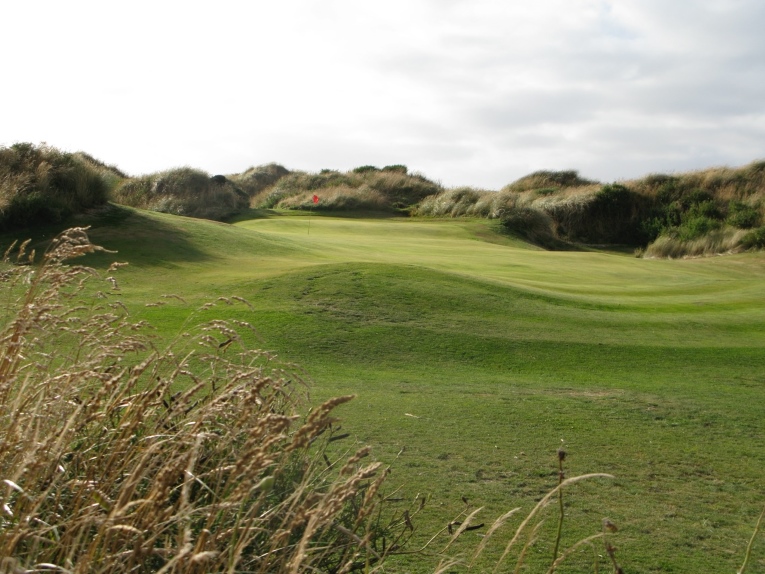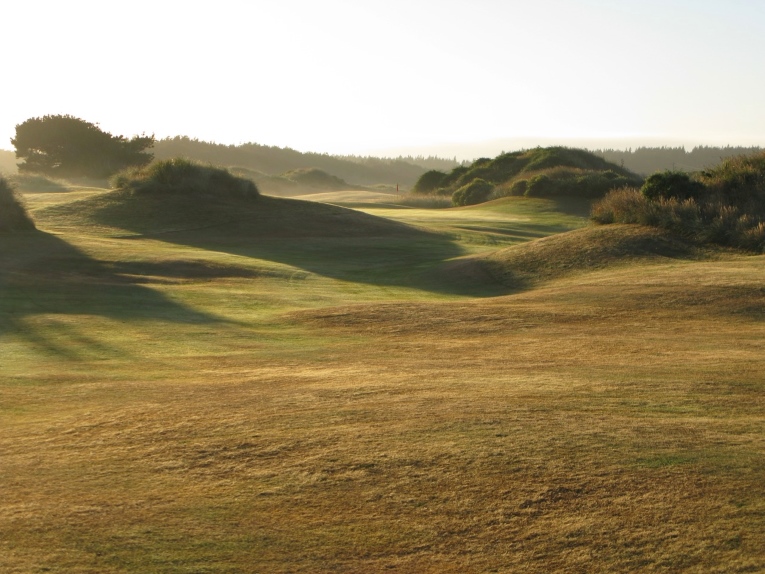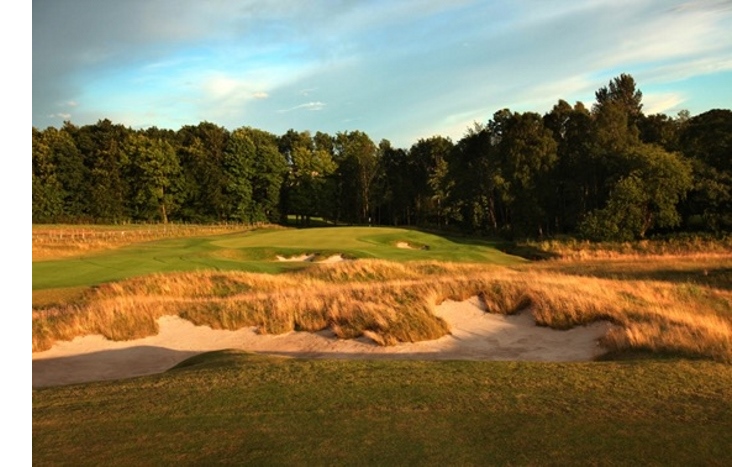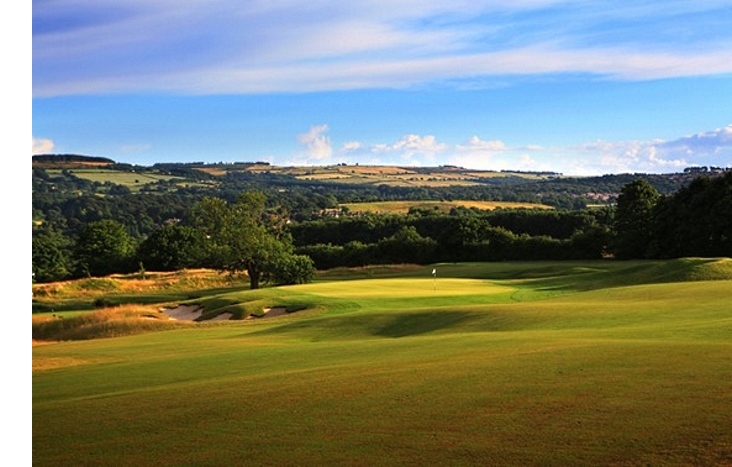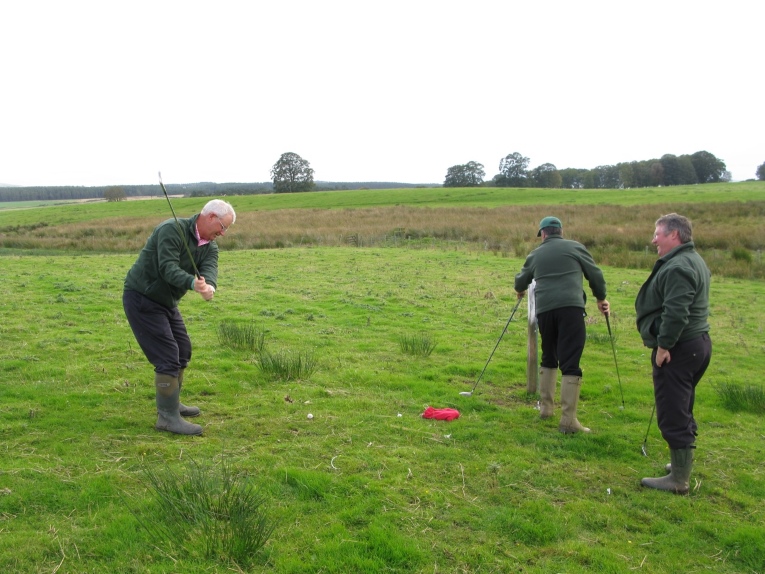with
Scott Macpherson
May, 2015
1. You grew up in New Zealand; what were the early influences on your life that drew you to golf and then golf architecture?
I had an outdoor childhood, and sports were an omnipresent feature, but golf somehow latched onto me when I first started to play at the age of 14. The early attraction was the dual and contrasting factors of golfing camaraderie while also being able to play and practise by myself. None of my family played golf but the professional at my local club was very encouraging. The transformational step came after I become a junior member at the Alex Russell designed Paraparaumu Beach Golf Club in the town where I went to high school. These links opened my eyes to how exciting golf courses could be as they have such wonderful movement and dunes of almost perfect scale that playing the championship course was an almost spiritual act. I think it was also important that the New Zealand Open was played on the course several times when I was there ( I caddied in 6 of them) which gave me an insight into why and how a great course could entertain a handicap player yet challenge a touring professional.
2. Tell us about your design philosophy and how you have come to embrace those tenets.
My predominant design philosophy is quite simple – I want to make my golf courses attractive and fun. The reason for these goals is that if my courses are fun, golfers will want to return, and that is usually what’s best for the client’s business and the ultimate compliment to the design. To achieve this, initially the focus is on finding the routing that will give golfers the most satisfactory experience of the site – and usually this means a walking experience. Then I try to break the journey up into par 3s, 4s and 5s as best determined by the site’s inherent topography and features. Like most designers I prefer not to start or finish on a par 3. I spend quite a lot of time thinking about the finishing sequence and really like to have a par 3 and 5 in the last four holes, ideally with a short par 4 in the mix also. Variety is a key to my philosophy and beyond a desire to dog-leg holes left to right and vice-versa, the determination is to design a range of interesting greens that fall within a unified theme.
Having my own children has broadened my design philosophies such that I understand more in depth the needs of young golfers and their parents. I like to think that a course I design could be played by a wide range of golfers and appeal as much to those entering the game and those slowing down. I happen to have a single figure handicap, and while being a low handicapper is not crucial to becoming a great golf course architect, I think it helps to understand the needs of different caliber of golfers, and to calculate the ease or difficulty of different shot values that might confront golfers as the design progresses from the drawing board through the construction phase, and to opening.
3. Has the current state of the game caused you to change your business plan or design intents?
I like the idea that you think I had a business plan…! But joking aside, I am very hands-on with my designs and some time ago ¬(over 10 years) I set up my UK based company to provide quality bespoke designs. The aim of this positioning was to attract a more discerning client, and to give them the time and attention they deserved. It was probably a key to securing work during the downturn. What this positioning has also done is reinforce my view that designing and renovating golf courses is an art-form and a privilege, and to focus on the client’s required outcome.
There are other aspects that are important to me. Part of the design process is being aware of the construction costs and the ensuing running costs of a golf course. I like to think that my designs are built on-time and on-budget and are delivering a package that are within the operational means of my clients and will benefit their business. Building environmentally aware golf courses has always been central to my designs as this was part of what I studied when I won a scholarship to attend UC Davis in 1991.
4. Tell us about your work at Oreti Sands with Greg Turner; it’s on very compelling land.
Greg had played at Oreti Sands (Southland Golf Club) as an amateur and thought that these links had not fulfilled there potential. Looking at the history of the course it is apparent that a reason for this may be due to the fact that those responsible for its layout had not survived the construction process. After the original architect died, the next chap in charge died too. The course was eventually finished, but it had some incongruous elements – perhaps due to a lack of design supervision continuity. Financed by the local community, Greg and I were able to survive long enough to add some new holes, discard some of the less cultured ones, and renumber the links. The result is a longer and more interesting links that moves from pure dunes land, through some trees, to a wetland area. It is quite a unique place – beautiful and raw, with no airs and graces. For those with an interest in trivia, it is also the most-southern links in the world.
5. New Zealand is gorgeous beyond belief. Any chance the golf will one day fully measure up to the potential of the two islands?
New Zealand has an evident egalitarian attitude with a spirit punctuated by a ‘get on and do it’ attitude. This was born and bred from the European men and women (mostly Brits) who first came to the country to set up farms, start businesses and find a ‘better’ life from the 19th century. Spread out across a vast land, many folk had little help so surviving was a case of rolling up the sleeves and getting on with it. And if a community wanted to have their own golf course, they often they got on and made it themselves. This greatly boosted the number of golf courses in NZ – indeed NZ is one of the two countries with the most number for golf courses per capita – but the quality of them could often waver.
Up until about the turn of the 21st century, the only golf course in NZ that was within the world’s Top 100 was Paraparaumu Beach – a course designed by the Australian Alex Russell, a man with experience in the art of golf courses design having worked at Royal Melbourne with Dr A. MacKenzie. More recently there have been some new, interesting, attractive and high profile courses built. These have mostly been of a higher quality than those pre-existing courses, and so perhaps now new courses are ‘measuring up the potential’ of the country’s beauty. I expect more wonderful golf courses will emerge in the future, but in a country with a land mass larger than the UK but less than 10% of their population, the new courses may be more for resort based guests, or for wealthy individuals than the general population.
6. In 2007 you authored a wonderful book, St Andrews, the Evolution of the Old Course. It is subtitled ‘The impact on golf, time tradition & technology’. What was the genesis of this project, how long did it take?
I am glad you liked the book. My research into the evolution of the Old Course began towards the end of a year caddying on the St Andrews links in 1999. I had come from working for Peter Thomson in Australia and had heard his stories of the Old Course and read quite widely about the links so I was somewhat surprised when many caddies kept telling their golfers stories about how all the bunkers were created by sheep and that the Old Course had never changed. After a period of being the on-site architect for two courses in St Andrews (now known as Fairmont St Andrews) I resumed work on a speadsheet in 2004 that documented all the lengths of all the holes for the Open Championships held in St Andrews. My research started with the first plan of the Old Course made in 1821 and it took two years to compile, but fairly quickly I could see that the links had changed quite considerably through the years. After showing the spreadsheet to a couple of friends I was encouraged to describe what I had discovered and ‘add a few photos’. After quite a bit more work and another two years, I finally published the book in 2007. I am proud that the book is the first to feature a collection of all the great plans of the links and documents, not just the lengthening of the links, but its elasticity and the reasons for the changes. The book is now sold exclusively by the Links Trust and has become the definitive guide to the history of the links. Given the most recent changes to the Old Course, and a little bit of prodding, I might be convinced to update it one day in the future.
7. What was the biggest surprise that you uncovered during the research for the St Andrews book?
I was amazed just how much the Old Course had changed. Apart from the changes to greens and bunkers, it was incredible to see that the links had not just been lengthened at certain times, but had also been shortened. The spreadsheet I worked on is included in the book so readers can see for themselves when, where and why the changes took place.
8. Today’s bunkers on The Old Course are all revetted, which helps allow the ever busy course to spring back into play quickly after severe storms. Your research showed that the bunkers once came in all sorts of shapes, sizes and forms. Do you lament how the bunkers have evolved?
For some time I have enjoyed looking at historic photos of the Old Course. A number of changes become apparent once I became more orientated with the layout of the links, but certainly the bunker changes are reasonably stark. I think you are right to suggest that revetting was a practical solution to the environmental conditions, though now it is their established theme. Personally I like a golf course to have a coherent bunker theme – it unites and harmonizes the aesthetic aspect of a course. The revetting of the larger bunkers on the Old Course – especially Hell Bunker – is almost a piece of art these days. The changes of the bunkers goes some distance to reinforce the fact that the course has, and continues to, evolve.
9. Has the research for that tome and the evolution of the Old Course influenced your design philosophy? Or perhaps the way that you build courses, understanding that they will likely change?
I have yet to build a ‘Hell Bunker’ or a cross-over hole (e.g. holes 7 and 11), but conducting the research gave me a greater sense of history, which is something I think is beneficial when it comes to golf course design as it broadens ones view of time and place. Studying the links elevated my appreciation for the benefits of undulations and the nuances of angle strategy. What I mean with the nuances of angle strategy is that on the Old Course being just one or two yards further left or right can greater alter the difficulty of a golfer’s next shot, or the view they might have to a green. I may not always employ this tactic on my courses, but I am surprised how often it might filter down into my conscious thought.
What the Old Course has in great amounts is a sense of place. This is something I do hope to include in a design if possible, but it is not easy to do. The idea being that if you were parachuted on a golf course, could you identify it? The Old Course has a sense of place, as does Pebble Beach and other lesser known clubs like Arrowtown Golf Club in New Zealand with its sharp rocky outcrops and bunker-less course also does. Another neat aspect to the Old Course are the ‘hubs’ (usually the double greens) where you will see and can communicate with other golfers as you play the course. I’ve always seen golf as a sociable game, and if I can unlock a routing that includes a hub around the tees – where non-sequential holes may come together (in a non-hazardous fashion) – then I am often tempted to do it.
10. Much fuss was made over the work carried out to The Old Course in the winter of 2013. Yet, the only constant on the Old Course is change. What are your thoughts on the overall work performed that winter?
I have stuck my head above the pulpit on this issue previously and said that as the Old Course has always changed, why is it that people want declare the links is perfect at this point in time, wrap it up in plastic and declare it a museum piece? The 1901 version of the links could have been better, or the 2050 version may turn out to provide the most fun and challenge to those with futuristic technology we have not yet imagined. Changes to the Old Course have mostly paralleled changes in technology (e.g. balls, shafts etc). Those in charge of the links have always had a responsibility to protect the course. Today, any changes need to undergo a litmus test that is arguably more stringent than for any other course and higher than at any point in history. With modern technology (web cams, GPS, Google Earth, Satellite TV etc) the world is constantly watching St Andrews and this creates a higher burden of proof that will in my estimations ensure only well planned and thought out adaptions ever take place on the Old Course. As for the work performed recently, I think the new bunkers on the 2nd hole are very good, as is the calibre of the work on the 11th green, and to the right of the 4th green. The ‘broken ground’ right of the 6th green looks a little humpy, but the idea was good and will soften over time. Very few people will notice any change to the bunker on the 17th green, which is a good sign indicating how little was actually done and that the quality of the workmanship was of the highest order. So tonsure your question, overall, I think that the changes will be well received.
11. Your second book is entitled Golf’s Royal Clubs and was commissioned by the R&A. Tell us what your goals were and how the project came about.
Yes, the book’s subtitle is ‘Honoured by the British Royal Family 1833-2013’. It covers 180 years from when the first golf club (Royal Perth Golf Club in Scotland) was granted a royal title, to the most recent club (Royal Port Moresby) in Papua New Guinea in 2012. The project came about because I was curious about the royal golf clubs. I had played a number in the UK, Australia and after Greg Turner and I won the commission to redesign Royal Wellington Golf Club in New Zealand, my need to know more about this special group of golf clubs grew to the point of requiring some action. Royal Wellington had been awarded the title ‘Royal’ from Her Majesty the Queen in 2004, but during the early stages of this design project I began wondering how many other royal clubs there were, where they were located, and how a club gets the title. That the R&A commissioned the book was more luck than anything else. Unbeknownst to me, they were quietly looking for an idea for The Queen’s Diamond Jubilee and my book just happened to float past them at the right moment, and Peter Dawson took it to the R&A’s General Committee. We all agreed that the book needed to be a complete and accurate celebration of those clubs that had been awarded the royal title from the British Royal Family. What was surprising just how dynamic the process still is. Indeed, when the R&A got on board there were 63 clubs around the world with this honour, but by the time the book was published in 2014 this had increased to 66!
To treat the clubs evenly we have given each of the clubs six pages and included maps of all their golf facilities. In the case on the Royal Montreal Golf Club, this means 45 holes, while the Royal Household Golf Club has only 9 holes. For the four clubs that do not own a golf course of their own – including the R&A – we have a full colour map of the course they play on most regularly (which is the Old Course for the R&A).
It was really interesting to note the different routes clubs had taken to attain the royal title and to clarify that the sovereign is the proper authority to grant the honour. We got significant new information via the National Archives in London and occasionally with assistance from the Freedom of Information Act in the UK which helped solve a number of questions for us. I am proud of the book, and delighted it has already won an award in the USA and been shortlisted for two other awards. I am also grateful that researching the book prompted me to get out and visit most of the royal clubs because apart from it really helping me understand more about the history of each club, I saw some really neat design features on some of their courses – perhaps, stuff that I can apply to my own work. Ultimately I visited 57 of the 66 clubs in 4 years of researching. Don’t tell anyone but I do harbour the desire to complete the “royal flush” in future years.
12. The royal book appears to be primarily about the golf clubs rather than the golf courses. Is there a connection to architecture?
You’re right, the book is about golf clubs, because as I said earlier, four of the 66 clubs do not own their own golf course. However, due to my background in design, I could not turn off my interest in the golf courses so in addition to providing maps of all the golf course, I have documented the golf course architects primarily connected to each course and often written about the course or its origins in the chapter accompanying each club history. On a personal and professional level, it was very interesting to walk or play the golf courses. I took a number of photos of the courses and it has helped me build a database that I can refer to in the future if necessary.
13. Some royal clubs possess world class courses like County Down, Melbourne, and Dornoch. Do you have a sense for how the culture of a club affects the presentation of its golf course? Or is it the other way around – does a looming 130 acre course outside the clubhouse windows set the tone inside as well?
Different clubs relate to the royal title in different ways. Certainly for the Royal Wellington Golf Club gaining the royal title pushed them to look at their facilities, compare them with other royal clubs in Australasia and ultimately embark on a multi-million dollar renovation process. So yes, having the royal title did change the culture of the club and bring with it a need to improve the presentation of their club facilities. Indeed, as part of their 27-holes they wanted to have a top class championship course, and I like to think that after the work I did there that they have that now.
As you say, Royal Melbourne and others take great pride in their facilities too. My sense is that there are other clubs that focus more on the club atmosphere than the course facilities, but there really is no ‘one way’ here. Amongst this unique group of clubs there are some well very known, wealthy, and influential clubs, and there are some lesser known clubs. It might be true that some clubs identify with the royal title more strongly than others, but in all the cases I can recall, each club was proud of their connection to the British Royal Family.
14. Royal Calcutta and Royal Malta are examples of courses found on less than ideal land. How does that impact the club culture?
Royal Malta is an interesting club with a long history – the early part of which is connected to the British Military. The club has the only course on the rocky island but has moved in its 125 years and is currently located next to the Marsa Sports Club where the horse racing course once was. The club has recently built a new clubhouse and holds aspirations to improve their playing facilities, which I am sure they will do so as they look to encourage more locals – especially juniors – to play. In what may seem like a flurry of activity, but just happens to coincide with your question, Royal Calcutta is also looking to improve their course. They sit on an incredibly valuable piece of land, but the course is not up to their aspirations so a remodel has been planned. I think that both clubs will feel a boost when their courses are updated, however, we have to remember that there are four clubs (The Royal Perth Golfing Society, R&A, Royal Montrose and Royal Epping Forest GC) that do not have their own golf course, so the culture of a club cannot be directly linked to the presence or calibre of their course.
15. How did Royal Baghdad Golf Club gain the royal appellation?
Little information exists about the Royal Baghdad Golf Club, but I think it was built in the 1920s by British residents and anointed by then King Faisal. It is not included in Golf’s Royal Clubs because it did not gain its royal title from the British Royal Family.
16. You have formed a design relationship with Lee Westwood. How has he influenced you and vice-versa?
I hope there may be cause to form a design relationship with Lee in the future, but we have not collaborated on any project yet. Lee is an ambassador for the Close House Golf Club in Newcastle, England – my first solo design in the UK. Lee had no design involvement with either course but was invited to open the championship ‘Colt Course’ in 2011 and so enjoyed the experience that he asked to join the team. The owner agreed and so I am delighted that Lee represents the facility on the world stage. Since then Lee has also opened the ‘Filly Course’ that I renovated in 2013. I am delighted that the Colt Course will be hosting its first real championship this year when the prestigious PGA Senior Championship is played there in June.
17. What can we expect at your latest project, Kersewell in Scotland?
Kersewell is a large development planned for rural South Lanarkshire, a county well-positioned about half way between Edinburgh and Glasgow – only 16 miles from Edinburgh. Construction is earmarked to start in 2016 and when completed, you can expect to find a full-length golf course rolled out over a 300 year old farm with attractive undulating land and holes strategically crafted to thrill golfers of all abilities. I think that future visitors can expect to be enthralled by the captivating countryside scenery as the course will provide long views out to the surrounding hills and moors. There are three strong reasons I am so excited about this project and confident that the course will be well-received. Firstly, having been involved with the master planning of the 485 acre property I have had the chance to lay the golf course out over the terrain I think is best-suited for a golf course. Secondly, the developers want the facility to help “grow the game” and so along with a practice area, they are proposing to include a six-hole facility for those new to the game, children, or golfers with time constraints. Thirdly, we have a great team to develop the golf courses:the contractors will be Edinburgh Landscapes who most recently worked on getting Gleneagles ready for the 2014 Ryder Cup and my co-designer is golfing superstar Sandy Lyle – a man who lives only 2 hours from the site.
18. After your extensive review and study of the evolution/changes at the Old Course which for nearly 2 centuries has been an important course for major competition, tourism and community, how do you think classic golf courses should be updated/ restored/ renovated? Should the process be different for different courses? Are there changes that would be taboo?
Could we start by trying to define a ‘classic course’? Shall we say they are those historic and celebrated golf courses that reflect the development of the game, that may have captured the best of a celebrated designer, and/or are the courses that signalled a change in direction for the industry. The Old Course is certainly a classic course for its history, as is Pine Valley for it design influence and say Huntercombe for displaying the work of Willie Park Jr. If we agree that Augusta National is also a classic course for say its impact on the game of golf via The Masters, then it is difficult to argue that changing a classic course is taboo as both it and the Old Course have been the subject of a number of changes through the years.
There are some changes to key features of classic courses that would be very difficult to justify, but as somewhat of a caveat, golf courses are living, growing, organic places that are, on a daily routine, being maintained (to some extent), so we can almost certainly agree that they have probably undergone a degree of ‘change’ already.
The discussion about renovating a classic course is related to what extent changes on a classic course are acceptable, the tipping point at which they are required, and the quality of design and supervision required to ensure any work conducted is of a satisfactory standard. I believe that restoring golf courses needs to be done on a course-by-course, hole-by-hole basis, and the process will change for each facility to reflect of their history, evolution, operation, financial position, location, future needs etc. A classic course does require greater consideration before any work is under taken, and an important step is to assess what features make the course a ‘classic’.
We then may look at what changes have taken place since the original architect completed the course. If the course is old – say 80, 100 years or more – then there is a good chance that there may have been a number of changes that have taken place, some of which are probably undocumented. Discovering these – be they strategic and/or physical (say new tees to combat improving playing equipment or new bunkers cut by greenkeepers or club committees), or vegetative (e.g. related to the growth of trees, sand build up on greens etc.), or a combination of all these and other factors, will help determine the extent of any restoration programme. So some restorations may be implemented purely with the goal of returning the features of a classic course to their original form/s.
There is much to consider when working on a classic course and the programme – be it an update, restoration or renovation – can be a wonderful challenge. The best results may come when an architect has a clear brief from the client, the research has been completed, the funds are available to do the necessary work, and all parties are committed to the project.
NB- Some of these remarks also apply to when the project is concerned with restoring the design integrity of a ‘classic’ golf hole – a hole which may or may not be on a classic golf course.




